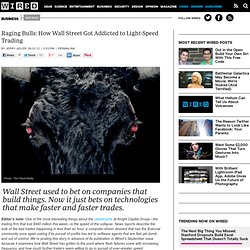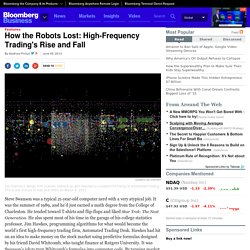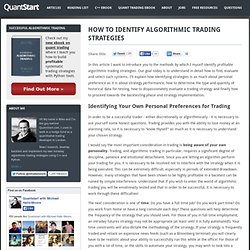

Raging Bulls: How Wall Street Got Addicted to Light-Speed Trading. Photo: Tim Flach/Getty Wall Street used to bet on companies that build things.

Now it just bets on technologies that make faster and faster trades. Editor’s note: One of the most interesting things about the catastrophe at Knight Capital Group—the trading firm that lost $440 million this week—is the speed of the collapse. News reports describe the bulk of the bad trades happening in less than an hour, a computer-driven descent that has the financial community once again asking if its pursuit of profits has led to software agents that are fast yet dumb and out of control. We’re posting this story in advance of its publication in Wired’s September issue because it examines how Wall Street has gotten to the point where flash failures come with increasing frequency, and how much further traders seem willing to go in pursuit of ever-greater speed.
Quantopian Brings Algorithmic Trading To The Masses. This Is How a Twitter-Based Hedge Fund Beat the Stock Market. You might think a 140 character tweet doesn't have much power, but, as one hedge fund proved, Twitter can help you win the stock market.

"Derwent Capital, the hedge fund that is using Twitter sentiment to make its investments, beat the market--and other hedge funds--in its first full month of trading," All Twitter's Lauren Dugan reports. Using an algorithm based on the social media mood that day, the hedge fund predicted the market to make the right trades. Sounds unbelievable that something cluttered with mundane musings and media links could have anything smart to say about the market. But it's working so far. The idea behind it. The number of emotional words on Twitter could be used to predict daily moves in the Dow Jones Industrial Average.
With such high accuracy, Derwent figured an algorithm that judged Twitter mood would fare well on the floor. What it actually does. But it's not all about the tweets. So far the formula has worked. How the Robots Lost: High-Frequency Trading's Rise and Fall. Steve Swanson was a typical 21-year-old computer nerd with a very atypical job.

It was the summer of 1989, and he’d just earned a math degree from the College of Charleston. He tended toward T-shirts and flip-flops and liked Star Trek: The Next Generation. He also spent most of his time in the garage of his college statistics professor, Jim Hawkes, programming algorithms for what would become the world’s first high-frequency trading firm, Automated Trading Desk.
Hawkes had hit on an idea to make money on the stock market using predictive formulas designed by his friend David Whitcomb, who taught finance at Rutgers University. It was Swanson’s job to turn Whitcomb’s formulas into computer code. Among the BORG’s first prey were the market makers on the floors of the exchanges who manually posted offers to buy and sell stocks with handwritten tickets. Graphic by StamenGraphic: Sixty Seconds of Chaos The definition of HFT varies, depending on whom you ask. Midas went live in February. Technical tools used to predict stock market trends. Day trading in stocks is risky, more so if you are untrained.

However, if you have an eye for spotting market trends, you can make a neat pile in quick intra-day deals. There was a time not long ago when trading was a simple game of buying and selling stocks based on one's conviction. Now, technical analysis- a science of predicting future prices from historical price data-has given investors new tools. "Technical analysis increases the probability of your call being right," says Abhijit Paul, assistant vice president, technicals, BRICS Securities. Simons at Renaissance Cracks Code, Doubling Assets (Update1) Jim Simons, Renaissance Technologies Corp. founder Nov. 27 (Bloomberg) -- On a hot afternoon in September, Renaissance Technologies LLC founder Jim Simons is too busy to take a phone call.

It is, he says, from Cumrun Vafa, a preeminent Harvard University professor and expert on string theory, which describes the building blocks of the universe as extended one-dimensional filaments. ``Get another time when I can talk to him,'' Simons tells his assistant. Then he mentions that the next day, he'll be meeting with Thomas Insel, director of the National Institute of Mental Health, to discuss autism research.
And he's slated that Saturday to host a gala honoring Math for America, or MFA, a four-year-old nonprofit he started that provides stipends to New York City math teachers. Interactive Brokers Demo Account Signup Tutorial - QuantStart. QuantSoftware ToolKit. Algo-trader - Algorithmic Trading Software. How to Identify Algorithmic Trading Strategies - QuantStart. In this article I want to introduce you to the methods by which I myself identify profitable algorithmic trading strategies.

Our goal today is to understand in detail how to find, evaluate and select such systems. I'll explain how identifying strategies is as much about personal preference as it is about strategy performance, how to determine the type and quantity of historical data for testing, how to dispassionately evaluate a trading strategy and finally how to proceed towards the backtesting phase and strategy implementation.
Identifying Your Own Personal Preferences for Trading In order to be a successful trader - either discretionally or algorithmically - it is necessary to ask yourself some honest questions.